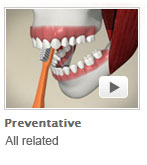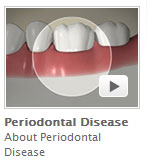
Hygiene and Gum Disease
Gum disease is one of the leading attributes of poor dental health. It is a bacterial infection that affects and inflames the gums resulting in destroying the tissues that support the teeth, including the gums and the tooth sockets. Also referred to as Gingivitis, this conditions occurs when harmful bacteria (plaque) begins growing in the region between the gums and the tooth’s roots. Signs of gum disease include:
- Bleeding during tooth brushing or flossing
- Receding gums
- Sensitive, red or swollen gums
- Bad breath
- Tooth pain or sensitivety
- Teeth that are loose or appear to have shifted from their original position
Good oral hygiene is the best prevention against gingivitis because it removes the plaque that causes the disorder. The teeth should be brushed at least twice daily and flossed gently at least once per day. For people who are prone to gingivitis, brushing and flossing may be recommended after every meal and at bedtime.
Healthy gums are pink and firm in appearance. Strict oral hygiene must be maintained for your whole life or gingivitis will recur.

